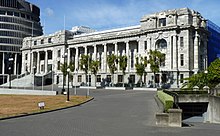| 40th Parliament of New Zealand | |||||||
|---|---|---|---|---|---|---|---|
| |||||||
 | |||||||
| Overview | |||||||
| Legislative body | New Zealand Parliament | ||||||
| Term | 6 April 1982 – 14 June 1984 | ||||||
| Election | 1981 New Zealand general election | ||||||
| Government | Third National Government | ||||||
| House of Representatives | |||||||
 | |||||||
| Members | 92 | ||||||
| Speaker of the House | Richard Harrison | ||||||
| Leader of the House | David Thomson | ||||||
| Prime Minister | Robert Muldoon | ||||||
| Leader of the Opposition | David Lange — Bill Rowling until 3 February 1983 | ||||||
| Sovereign | |||||||
| Monarch | Elizabeth II | ||||||
| Governor-General | David Beattie | ||||||
| Sessions | |||||||
| |||||||
The 40th New Zealand Parliament was a term of the Parliament of New Zealand. Its composition was determined by the 1981 election, and it sat until the 1984 election.
The 40th Parliament was the third and final term of the third National Party government. Robert Muldoon, who served as both Prime Minister and Minister of Finance, remained in power. The Labour Party, led by former Prime Minister Bill Rowling, had made significant gains (actually winning the largest portion of the popular vote), but remained in opposition. The Social Credit Party was the only other opposition party in the 40th Parliament, holding two seats.
The 40th Parliament consisted of ninety-two representatives, the same as in the previous election. All of these representatives were chosen by single-member geographical electorates, including four special Māori electorates.